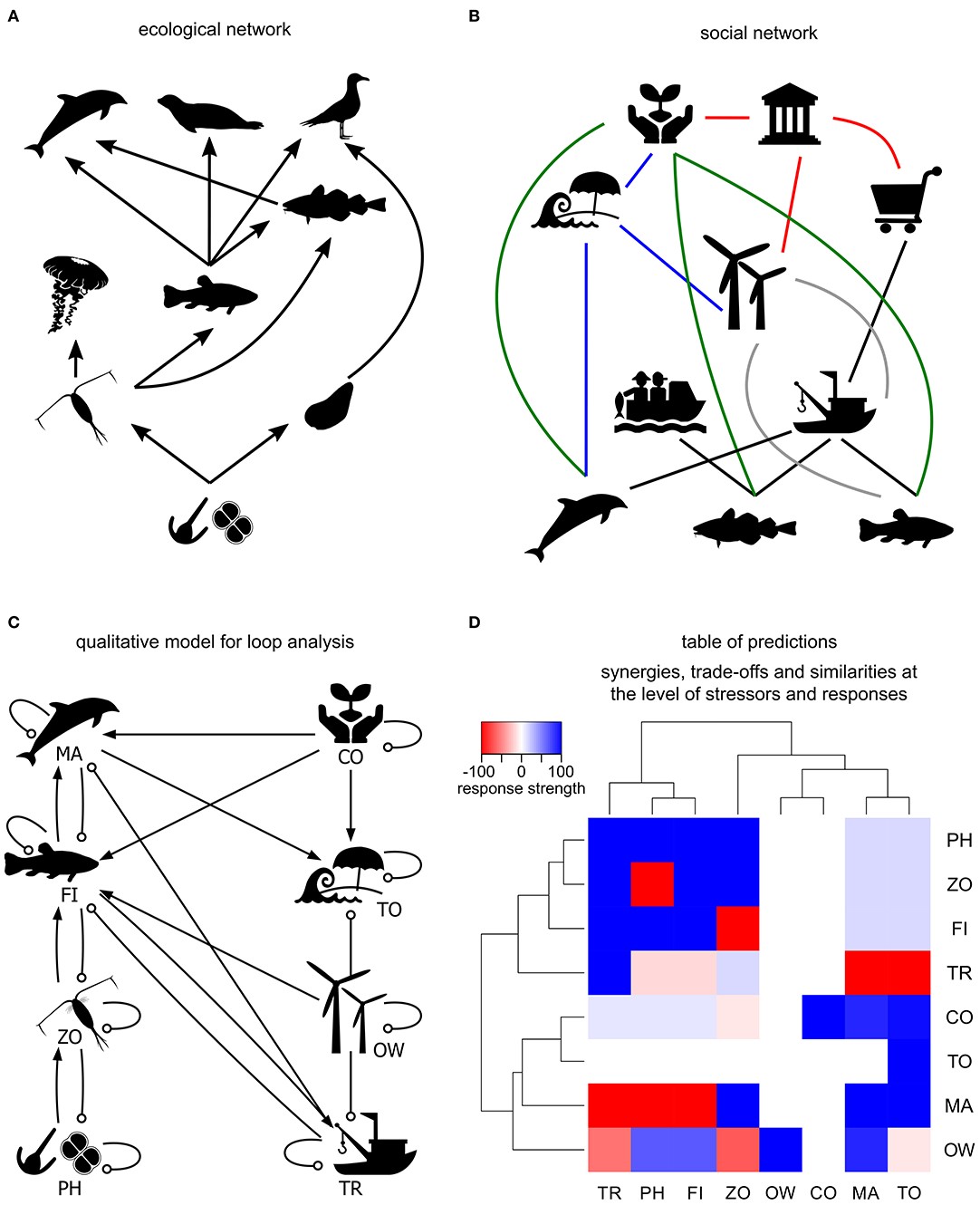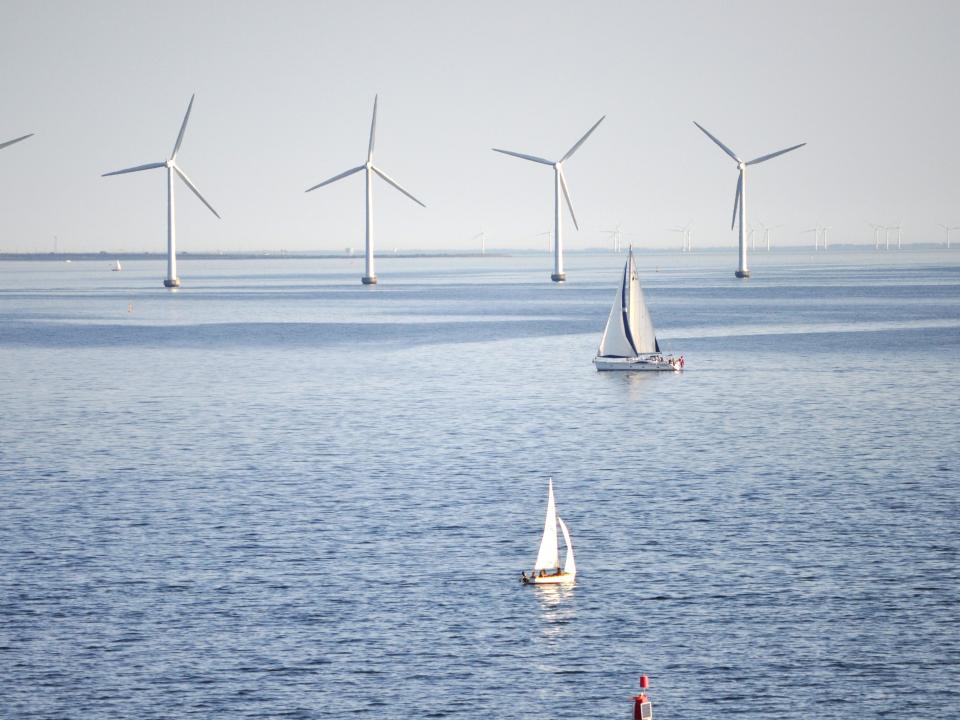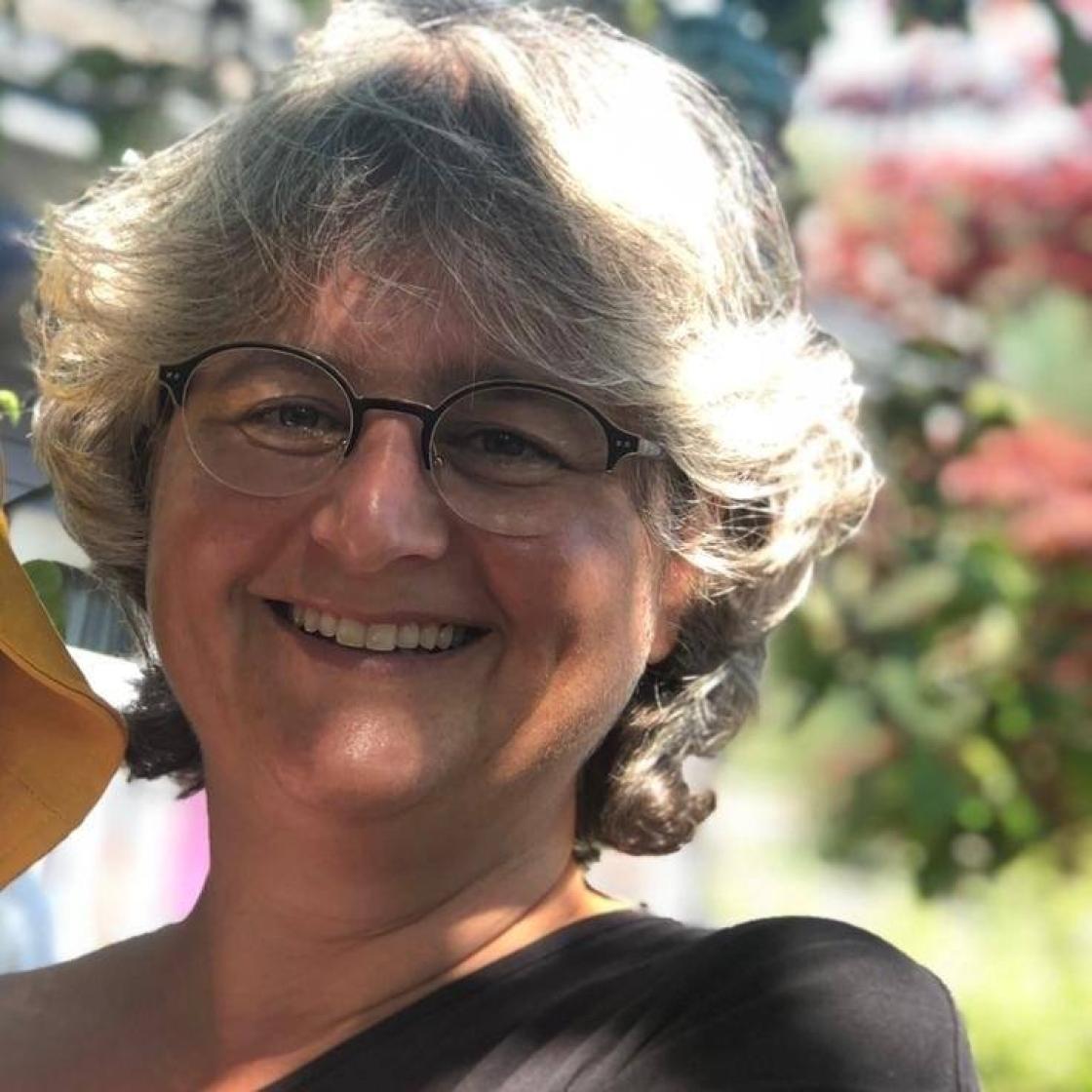Niquil, N., Scotti, M., Fofack-Garcia, R., Haraldsson, M., Thermes, M., Raoux, A., Le Loc’h F. & Mazé, C. (2021). The Merits of Loop Analysis for the Qualitative Modeling of Social-Ecological Systems in Presence of Offshore Wind Farms. Frontiers in Ecology and Evolution, 9, 35. https://doi.org/10.3389/fevo.2021.635798
Offshore wind farms (OWF) create, through their physical appearance along our coastlines and through the different ways they may alter the marine ecosystem from which humans depend, the emergence of a new social-ecological system (SES). Diverse interaction types between human and natural actors characterize this novel system. This can be for example the impact that offshore wind farms have on the composition of the food web, which is the basis of the functioning of the ecosystem through interactions that regulate energy circulation, and consequently human benefits from ecosystem productivity. Human actors’ interactions network forms the basis for the decisions about the authorization of building and developing new offshore farms for example, and can include sentimental aspects. These interactions can be identified through social fieldwork, report analysis and interviews, building the basis for the social network. However, we often assume that the most important part of complexity lies at the interface between society and ecosystems, thus omitting to study how indirect effects spread and distribute their feedback in the entire SES. This can be captured by adding complexity to both subsystems. In this opinion paper, we are highlighting the uniqueness of the SES emerging from OWF projects, and we discuss how qualitative models and loop analysis can be used to address some of the challenges encountered when modelling these unique SES. Loop analysis eases the integration of interactions involving different currencies and for which information about quantities is often lacking. The modelling of the entire SES enveloping OWF, including ecological, socioeconomic and political variables, represents the ideal solution to understand the complexity that is inherent in these systems and affect the governance of the social-ecosystem.
Contact: Nathalie Niquil, nathalie.niquil@unicaen.fr
Picture title:
Des réseaux écologiques et sociaux au réseau socio-écologique et à son analyse par la ‘loop analysis’.
From ecological and social networks to predictions of SES dynamics with loop analysis. The ecological network (A) depicts trophic interactions in a hypothetical food web (arrows indicate energy flow direction). The social network (B) shows a toy model with biomass flows (black) and governmental (red) relationships together with conservation (green), marine protection (gray) and perception (blue). Animals in the social network represent the interface through which social actors directly interact with the ecosystem. A selection of variables from the ecological and social systems allows building the qualitative model of the SES (C) with positive (arrow-headed) and negative (circle-headed) relationships (i.e., digraph). The table of predictions (D) derived from the digraph describes expected changes in column variables triggered by positive press perturbations on row variables. The clustering along the rows and the columns accounts for similarities in the impacts generated and the responses, respectively. Codes: PH, phytoplankton; ZO, zooplankton; FI, forage fishes; MA, marine mammals; TR, trawl fisheries; CO, conservation; TO, tourism; OW, offshore wind farms. Copyright : © Niquil et al 2021, Frontiers in Marine Science.
Offshore wind farms (OWF) create, through their physical appearance along our coastlines and through the different ways they may alter the marine ecosystem from which humans depend, the emergence of a new social-ecological system (SES). Diverse interaction types between human and natural actors characterize this novel system. This can be for example the impact that offshore wind farms have on the composition of the food web, which is the basis of the functioning of the ecosystem through interactions that regulate energy circulation, and consequently human benefits from ecosystem productivity. Human actors’ interactions network forms the basis for the decisions about the authorization of building and developing new offshore farms for example, and can include sentimental aspects. These interactions can be identified through social fieldwork, report analysis and interviews, building the basis for the social network. However, we often assume that the most important part of complexity lies at the interface between society and ecosystems, thus omitting to study how indirect effects spread and distribute their feedback in the entire SES. This can be captured by adding complexity to both subsystems. In this opinion paper, we are highlighting the uniqueness of the SES emerging from OWF projects, and we discuss how qualitative models and loop analysis can be used to address some of the challenges encountered when modelling these unique SES. Loop analysis eases the integration of interactions involving different currencies and for which information about quantities is often lacking. The modelling of the entire SES enveloping OWF, including ecological, socioeconomic and political variables, represents the ideal solution to understand the complexity that is inherent in these systems and affect the governance of the social-ecosystem.
Contact: Nathalie Niquil, nathalie.niquil@unicaen.fr
Picture title:
Des réseaux écologiques et sociaux au réseau socio-écologique et à son analyse par la ‘loop analysis’.
From ecological and social networks to predictions of SES dynamics with loop analysis. The ecological network (A) depicts trophic interactions in a hypothetical food web (arrows indicate energy flow direction). The social network (B) shows a toy model with biomass flows (black) and governmental (red) relationships together with conservation (green), marine protection (gray) and perception (blue). Animals in the social network represent the interface through which social actors directly interact with the ecosystem. A selection of variables from the ecological and social systems allows building the qualitative model of the SES (C) with positive (arrow-headed) and negative (circle-headed) relationships (i.e., digraph). The table of predictions (D) derived from the digraph describes expected changes in column variables triggered by positive press perturbations on row variables. The clustering along the rows and the columns accounts for similarities in the impacts generated and the responses, respectively. Codes: PH, phytoplankton; ZO, zooplankton; FI, forage fishes; MA, marine mammals; TR, trawl fisheries; CO, conservation; TO, tourism; OW, offshore wind farms. Copyright : © Niquil et al 2021, Frontiers in Marine Science.





